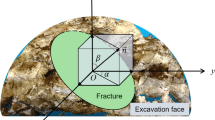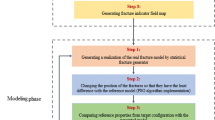Abstract
The clustering and classification of fracture orientation data are crucial tasks in geotechnical engineering and rock engineering design. The explicit simulation of fracture orientations is always applied to compensate for the lack of direct measurements over the entire rock mass. In this study, a single step approach based on the theory of finite mixture models, where the component distributions are Fisher distributions, is proposed for automatic clustering and simulation of fracture orientation data. In the proposed workflow, the spherical K-means algorithm is applied to select the initial cluster centers, and the component-wise expectation–maximization algorithm using the minimum message length criterion is used to automatically determine the optimal number of fracture sets. An additional advantage of the proposed method is the representation of orientation data using a full sphere, instead of the conventional hemispherical characterization. The use of a full spherical representation effectively solves the issue of clustering for fractures with high dip angles. In addition, the calculation process of the mean direction is also simplified. The effectiveness of the model-based clustering method is tested with a complicated artificial data set and two real world data sets. Cluster validity is introduced to evaluate the clustering results. In addition, two other clustering algorithms are also presented for comparison. The results demonstrate that the proposed method can successfully detect the optimal number of clusters, and the parameters of the distributions are well estimated. In addition, the proposed method also exhibits good computational performance.















Similar content being viewed by others
References
Akaike H (1974) A new look at the statistical model identification. IEEE Trans Autom Control 19:716–723
Alghalandis YF, Dowd PA, Xu C (2014) Connectivity field: a measure for characterising fracture networks. Math Geosci 47:63–83
Banerjee A, Dhillon IS, Ghosh J, Sra S (2005) Clustering on the unit hypersphere using von Mises–Fisher distributions. J Mach Learn Res 6:1345–1382
Bingham C (1974) An antipodally symmetric distribution on the sphere. Ann Stat 2:1201–1225
Cao YH, Feng XT, Yan EC, Chen G, Lu FF, Ji HB, Song KY (2015) Calculation method and distribution characteristics of fracture hydraulic aperture from field experiments in fractured granite area. Rock Mech Rock Eng 49:1629–1647
Conway JH (1998) Sphere packing, lattices and groups. American Mathematical Monthly, 3rd edn. Spinger, New York
Dhillon IS, Modha DS (2001) Concept decompositions for large sparse text data using clustering. Mach Learn 42:143–175
Dowd PA, Xu CS, Mardia K, Fowell R (2007) A comparison of methods for the stochastic simulation of rock fractures. Math Geol 39:697–714
Dowe DL, Oliver JJ, Wallace CS (1996) MML estimation of the parameters of the spherical fisher distribution. Springer, Berlin
Fadakar Alghalandis Y, Dowd PA, Xu C (2013) The RANSAC method for generating fracture networks from micro-seismic event data. Math Geosci 45:207–224
Figueiredo MAT, Jain AK (2002) Unsupervised learning of finite mixture models. IEEE Trans Pattern Anal Mach Intell 24:381–396
Fisher NI, Lewis T, Embleton BJ (1987) Statistical analysis of spherical data. Cambridge University Press, London
Fisher R (1953) Dispersion on a Sphere. Proc R Soc Lond Ser A 217:295–305
Hammah RE, Curran JH (1998) Fuzzy cluster algorithm for the automatic identification of joint sets. Int J Rock Mech Min Sci 35:889–905
Hammah RE, Curran JH (1999) On distance measures for the Fuzzy K-means algorithm for joint data. Rock Mech Rock Eng 32:1–27
Hammah RE, Curran JH (2000) Validity measures for the fuzzy cluster analysis of orientations. IEEE Trans Pattern Anal Mach Intell 22:1467–1472
Han XD, Chen JP, Wang Q, Li YY, Zhang W, Yu TW (2016) A 3D fracture network model for the undisturbed rock mass at the Songta dam site based on small samples. Rock Mech Rock Eng 49:611–619
Hornik K, Feinerer I, Kober M, Buchta C (2016) Spherical k-means clustering. J Stat Soft 50:1–22
Hornik K, Wu WW, Grün B, Kepler J, Linz U (2014) movMF: An R package for fitting mixtures of von Mises–Fisher distributions. J Stat Soft 058:1–31
ISRM (1978) International Society for Rock Mechanics commission on standardization of laboratory and field tests: Suggested methods for the quantitative description of discontinuities in rock masses. Int J Rock Mech Min Sci Geomech Abstr 15:319–368
Jimenez-Rodriguez R, Sitar N (2006) A spectral method for clustering of rock discontinuity sets. Int J Rock Mech Min Sci 43:1052–1061
Jimenez R (2008) Fuzzy spectral clustering for identification of rock discontinuity sets. Rock Mech Rock Eng 41:929–939
Kasarapu P, Allison L (2015) Minimum message length estimation of mixtures of multivariate Gaussian and von Mises–Fisher distributions. Mach Learn 100:333–378
Klose CD, Seo S, Obermayer K (2005) A new clustering approach for partitioning directional data. Int J Rock Mech Min Sci 42:315–321
Kulatilake PSW (1986) Bivariate normal distribution fitting on discontinuity orientation clusters. Math Geol 18:181–195
Li YY, Wang Q, Chen JP, Song SY, Ruan YK, Zhang Q (2015a) A multivariate technique for evaluating the statistical homogeneity of jointed rock masses. Rock Mech Rock Eng 48:1821–1831
Li YY, Wang Q, Chen JP, Xu LM, Song SY (2015b) K-means algorithm based on particle swarm optimization for the identification of rock discontinuity sets. Rock Mech Rock Eng 48:375–385
Liu DA, Wang SJ, Li LY (2000) Investigation of fracture behaviour during rock mass failure. Int J Rock Mech Min Sci 37:489–497
Lopes P, Lana M (2016) Analytical method for calculating the volume of rock blocks using available mapping data field. Math Geosci 49:217–229
Ma GW, Xu ZH, Zhang W, Li SC (2014) An enriched K-means clustering method for grouping fractures with meliorated initial centers. Arab J Geosci 8:1881–1893
Marcotte D, Henry E (2002) Automatic joint set clustering using a mixture of bivariate normal distributions. Int J Rock Mech Min Sci 39:323–334
Mardia KV, Jupp PE (1999) Directional statistics. Wiley series in probability and mathematical statistics. Wiley, Chichester
McLachlan GJ, Basford KE (1988) Mixture models. Inference and applications to clustering. Statistics: Textbooks and Monographs. Dekker, New York
Neal RM, Hinton GE (1998) A view of the EM algorithm that justifies incremental, sparse, and other variants. In: Jordan MI (ed) Learning in graphical models. Springer, Dordrecht, pp 355–368
Oliver JJ, Baxter RA, Wallace CS (1999) Unsupervised learning using MML. In: Machine learning: proceedings of the 13th international conference, pp 364–372
Peel D, Mclachlan GJ (2001) Fitting mixtures of Kent distributions to aid in joint set identification. J Am Stat Assoc 96:56–63
Priest SD (1993) Discontinuity analysis for rock engineering. Chapman & Hall, London
Rissanen J (1989) Stochastic complexity in statistical inquiry, vol 15. World Scientific, Singapore
Schwarz G (1978) Estimating the dimension of a model. Ann Stat 6:461–464
Shanley RJ, Mahtab MA (1976) Delineation and analysis of clusters in orientation data. Math Geol 8:9–23
Shannon CE (1948) A mathematical theory of communication. Bell Syst Tech J 27:379–423
Silvestre C, Cardoso MGMS, Figueiredo MAT (2014) Identifying the number of clusters in discrete mixture models. Eprint Arxiv
Singh M, Rao KS (2005) Empirical methods to estimate the strength of jointed rock masses. Eng Geol 77:127–137
Singh M, Rao KS, Ramamurthy T (2002) Strength and deformational behaviour of a jointed rock mass. Rock Mech Rock Eng 35:45–64
Snyder JP (1987) Map projections—a working manual, vol 1395. Geological Survey professional paper. U.S. Government Printing Office, Washington, DC
Ulrich G (1984) Computer generation of distributions on the m-sphere. J Roy Stat Soc Ser C (Appl Stat) 33:158–163
Wallace CS (2005) Statistical and inductive inference by Minimum Message Length (information science and statistics). Springer, New York
Wallace CS, Boulton DM (1968) An information measure for classification. Comput J 11:185–194
Wallace CS, Boulton DM (1975) An invariant Bayes method for point estimation. Classif Soc Bull 3:11–34
Wallace CS, Dowe DL (1994) Estimation of the von Mises concentration parameter using Minimum Message Length. In: Proceedings of the 12th Australian statistical society conference, Monash University, Australia
Wallace CS, Dowe DL (1999) Minimum message length and Kolmogorov complexity. Comput J 42:270–283
Wallace CS, Dowe DL (2000) MML clustering of multi-state, Poisson, von Mises circular and Gaussian distributions. Stat Comput 10:73–83
Wallace CS, Freeman PR (1987) Estimation and inference by compact coding. J Roy Stat Soc 49:240–252
Watson GS, Williams EJ (1956) On the construction of significance tests on the circle and the sphere. Biometrika 43:222–223
Wood ATA (1994) Simulation of the von mises fisher distribution. Commun Stat Simul C 23:157–164
Xu CS, Dowd P (2010) A new computer code for discrete fracture network modelling. Comput Geosci 36:292–301
Xu LM, Chen JP, Wang Q, Zhou FJ (2013) Fuzzy C-means cluster analysis based on mutative scale Chaos optimization algorithm for the grouping of discontinuity sets. Rock Mech Rock Eng 46:189–198
Yamaji A, Sato K (2011) Clustering of fracture orientations using a mixed Bingham distribution and its application to paleostress analysis from dike or vein orientations. J Struct Geol 33:1148–1157
Zeng H, Cheung YM (2014) Learning a mixture model for clustering with the completed likelihood minimum message length criterion. Pattern Recognit 47:2011–2030
Zhan JW, Xu PH, Chen JP, Zhang W, Niu CC, Han XD (2016) A stepwise approach for 3D fracture intersection analysis and application to a hydropower station in Southwest China. Int J Rock Mech Min Sci 89:116–128
Zhang W, Chen JP, Chen H, Xu DZ, Li YY (2013) Determination of RVE with consideration of the spatial effect. Int J Rock Mech Min Sci 61:154–160
Zhang W, Chen JP, Liu C, Huang R, Li M, Zhang Y (2012) Determination of geometrical and structural representative volume elements at the Baihetan dam site. Rock Mech Rock Eng 45:409–419
Zheng J, Deng JH, Yang XJ, Wei JB, Zheng HC, Cui YL (2014) An improved Monte Carlo simulation method for discontinuity orientations based on Fisher distribution and its program implementation. Comput Geotech 61:266–276
Zhong S (2005) Efficient online spherical k-means clustering. In: IEEE international joint conference on neural networks, pp 3180–3185
Zhou W, Maerz NH (2002) Implementation of multivariate clustering methods for characterizing discontinuities data from scanlines and oriented boreholes. Comput Geosci 28:827–839
Acknowledgements
The authors gratefully acknowledge the support from the State Key Program of National Natural Science Fund of China (Grant No. 41330636), the National Natural Science Fund of China (Grant Nos. 41402242 and 41302218), and the Graduate Innovation Fund of Jilin University (Grant Nos. 2017137 and 2016208). We would like to thank the editors and two anonymous reviewers for their in depth comments and valuable suggestions.
Author information
Authors and Affiliations
Corresponding author
Rights and permissions
About this article
Cite this article
Zhan, J., Chen, J., Xu, P. et al. Automatic Identification of Rock Fracture Sets Using Finite Mixture Models. Math Geosci 49, 1021–1056 (2017). https://doi.org/10.1007/s11004-017-9702-1
Received:
Accepted:
Published:
Issue Date:
DOI: https://doi.org/10.1007/s11004-017-9702-1




